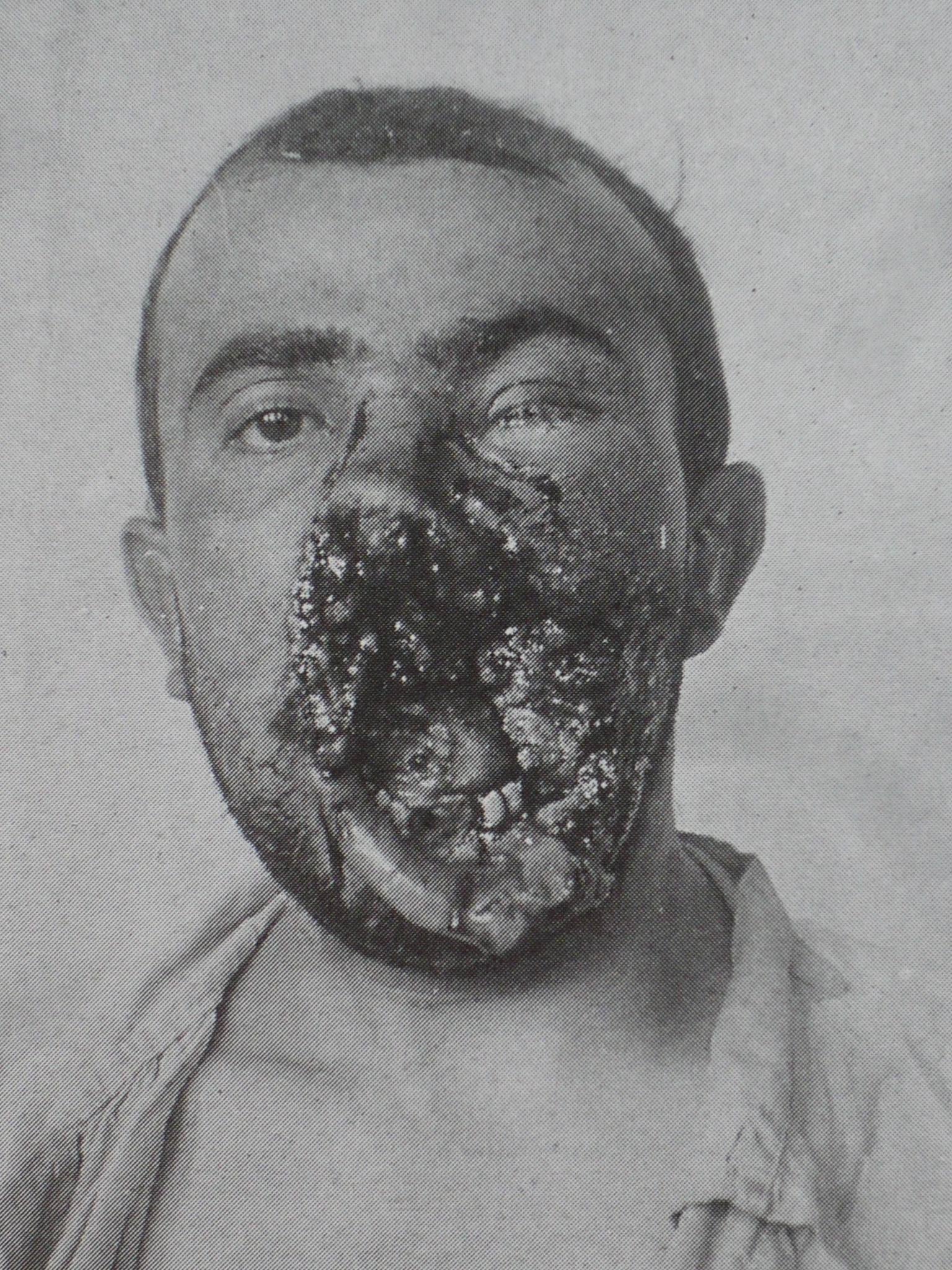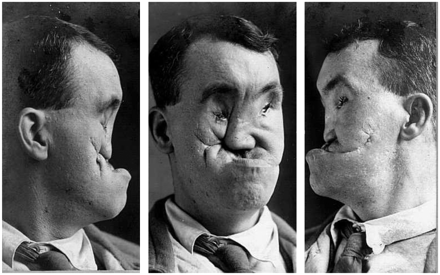The French also had the highest percentage of wounded of all the major belligerents:
Sorted by percent wounded of total Mobilized Dead % Wounded % Missing/PoW % France 16.36% 50.73% 6.39% Austria-Hungary 15.38% 46.41% 28.21% Russia 14.17% 41.25% 20.83% Germany 16.12% 38.33% 10.48% Great Britain 10.20% 23.47% 2.15%
Sorted by number wounded Mobilized Dead Wounded Missing/PoW Russia 12,000,000 1,700,000 4,950,000 2,500,000 France 8,410,000 1,375,800 4,266,000 537,000 Germany 11,000,000 1,773,700 4,216,058 1,152,800 Austria-Hungary 7,800,000 1,200,000 3,620,000 2,200,000 Great Britain 8,904,467 908,371 2,090,212 191,652 Italy 5,615,000 650,000 947,000 600,000
The hydraulic effects of explosions in mud made the awfulness even worse.
Combine the horror of the wounds with advances in medicine that kept the organism alive where in earlier history the soldier would have died, and the result was tens of thousands of men who had to face life without a face.
When we speak of "the wounded" we really have no idea of the reality.
Warning: What follows is very graphic.
IntroductionSmithsonian Magazine, February, 2007
Faces of War
Amid the horrors of World War I, a corps of artists brought hope to soldiers disfigured in the trenches
Wounded tommies facetiously called it "The Tin Noses Shop." Located within the 3rd London General Hospital, its proper name was the "Masks for Facial Disfigurement Department"; either way, it represented one of the many acts of desperate improvisation borne of the Great War, which had overwhelmed all conventional strategies for dealing with trauma to body, mind and soul. On every front—political, economic, technological, social, spiritual—World War I was changing Europe forever, while claiming the lives of 8 million of her fighting men and wounding 21 million more.
The large-caliber guns of artillery warfare with their power to atomize bodies into unrecoverable fragments and the mangling, deadly fallout of shrapnel had made clear, at the war's outset, that mankind's military technology wildly outpaced its medical: "Every fracture in this war is a huge open wound," one American doctor reported, "with a not merely broken but shattered bone at the bottom of it." The very nature of trench warfare, moreover, proved diabolically conducive to facial injuries: "[T]he...soldiers failed to understand the menace of the machine gun," recalled Dr. Fred Albee, an American surgeon working in France. "They seemed to think they could pop their heads up over a trench and move quickly enough to dodge the hail of bullets."
Writing in the 1950s, Sir Harold Gillies, a pioneer in the art of facial reconstruction and modern plastic surgery, recalled his war service: "Unlike the student of today, who is weaned on small scar excisions and graduates to harelips, we were suddenly asked to produce half a face." A New Zealander by birth, Gillies was 32 and working as a surgeon in London when the war began, but he left shortly afterward to serve in field ambulances in Belgium and France. In Paris, the opportunity to observe a celebrated facial surgeon at work, together with the field experience that had revealed the shocking physical toll of this new war, led to his determination to specialize in facial reconstruction. Plastic surgery, which aims to restore both function and form to deformities, was, at the war's outset, crudely practiced, with little real attention given to aesthetics. Gillies, working with artists who created likenesses and sculptures of what the men had looked like before their injuries, strove to restore, as much as possible, a mutilated man's original face. Kathleen Scott, a noted sculptress and the widow of Capt. Robert Falcon Scott of Antarctica fame, volunteered to help Gillies, declaring with characteristic aplomb that the "men without noses are very beautiful, like antique marbles."
While pioneering work in skin grafting had been done in Germany and the Soviet Union, it was Gillies who refined and then mass-produced critical techniques, many of which are still important to modern plastic surgery: on a single day in early July 1916, following the first engagement of the Battle of the Somme—a day for which the London Times casualty list covered not columns, but pages—Gillies and his colleagues were sent some 2,000 patients. The clinically honest before-and-after photographs published by Gillies shortly after the war in his landmark Plastic Surgery of the Face reveal how remarkably—at times almost unimaginably—successful he and his team could be; but the gallery of seamed and shattered faces, with their brave patchwork of missing parts, also demonstrates the surgeons' limitations. It was for those soldiers—too disfigured to qualify for before-and-after documentation—that the Masks for Facial Disfigurement Department had been established.
"My work begins where the work of the surgeon is completed," said Francis Derwent Wood, the program's founder. Born in England's Lake District in 1871, of an American father and British mother, Wood had been educated in Switzerland and Germany, as well as England. Following his family's return to England, he trained at various art institutes, cultivating a talent for sculpture he had exhibited as a youth. Too old for active duty when war broke out, he had enlisted, at age 44, as a private in the Royal Army Medical Corps. Upon being assigned as an orderly to the 3rd London General Hospital, he at first performed the usual "errand-boy-housewife" chores. Eventually, however, he took upon himself the task of devising sophisticated splints for patients, and the realization that his abilities as an artist could be medically useful inspired him to construct masks for the irreparably facially disfigured. His new metallic masks, lightweight and more permanent than the rubber prosthetics previously issued, were custom designed to bear the prewar portrait of each wearer. Within the surgical and convalescent wards, it was grimly accepted that facial disfigurement was the most traumatic of the multitude of horrific damages the war inflicted. "Always look a man straight in the face," one resolute nun told her nurses. "Remember he's watching your face to see how you're going to react."The Wounded
Wood established his mask-making unit in March 1916, and by June 1917, his work had warranted an article in The Lancet, the British medical journal. "I endeavour by means of the skill I happen to possess as a sculptor to make a man's face as near as possible to what it looked like before he was wounded," Wood wrote. "My cases are generally extreme cases that plastic surgery has, perforce, had to abandon; but, as in plastic surgery, the psychological effect is the same. The patient acquires his old self-respect, self assurance, self-reliance,...takes once more to a pride in his personal appearance. His presence is no longer a source of melancholy to himself nor of sadness to his relatives and friends."
Toward the end of 1917, Wood's work was brought to the attention of a Boston-based American sculptor, inevitably described in articles about her as a "socialite." Born in Bryn Mawr, Pennsylvania, Anna Coleman Watts had been educated in Paris and Rome, where she began her sculptural studies. In 1905, at the age of 26, she had married Maynard Ladd, a physician in Boston, and it was here that she continued her work. Her sculptural subjects were mostly decorative fountains—nymphs abounding, sprites dancing—as well as portrait busts that, by today's tastes, appear characterless and bland: vaguely generic portraits of vaguely generic faces. The possibility of furthering the work by making masks for wounded soldiers in France might not have been broached to Ladd but for the fact that her husband had been appointed to direct the Children's Bureau of the American Red Cross in Toul and serve as its medical adviser in the dangerous French advance zones....MORE
This is what the surgeons were dealing with:

Where do you start?
And this

The doctors could keep you alive but then what?
And this

This is where the sculptors stepped in after the surgeons had done the best they could.
People like Wood and Ladd made masks for the disfigured who, one way or another were going to be turned back into civilian society.
The artistry was amazing



Two soldiers play cards while wearing Ladd’s handiwork.
The SurgeonsLed by Dr. Gillies, Queen Mary's Hospital, Sidcup, London became the world's leading institution for the research and practice of plastic and reconstructive surgery. The work they did is is deserving of much more space than we can give it here, it would require an entire website of its own.
Fortunately there is one:
The Gillies Archives from Queen Mary's Hospital, SidcupFinally, if any good has come of all this, it is the advances in medicine/surgery:
That's Katie Stubblefield's new face just before the transplant surgery
Good for her but it seems an awfully high price was paid to get us to this point.